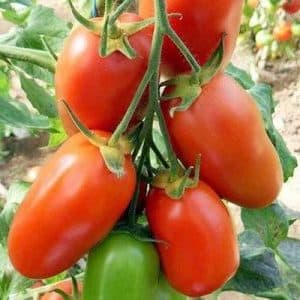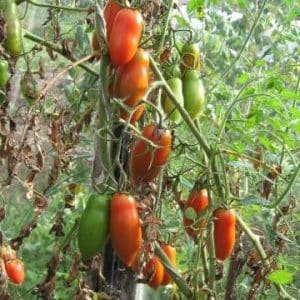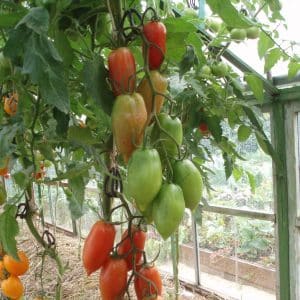Can the “Krasavchik” tomato not only decorate your garden bed, but also produce a good harvest?
The Handsome tomato is grown by many gardeners. Against the general background of many crops, hybrids have an undeniable advantage: being unpretentious in care, it produces a high yield. Even inexperienced gardeners will be able to please themselves with fresh tomatoes if they follow the rules of growing and caring for the crop.
In the article we will give the characteristics and description of the hybrid, and list the pros and cons of this handsome tomato.
Description and yield indicators
Tomato Krasavchik f1 was included in the register of breeding achievements in 2008. The hybrid does not require special attention to care, but produces a bountiful harvest. It differs in the average period of fruit ripening. Recommended for cultivation in personal gardens under film covers.
The plant has the following characteristics:
- The bush is tall, continues to lengthen after the formation of inflorescences, reaching 1.5–2 m in height.
- The fruits are collected on the branches in clusters of 8–12 pieces.
- Tomatoes ripen 100–115 days after planting the seeds.
- It has dense and strong stems.
- The shoots and foliage are pubescent on the front side and are colored rich green.
- The branches are spreading, for this reason the plants need supports and obligatory garter.
- Red fruits of round or cylindrical shape weigh 50–100 g. They have dense and fleshy pulp with a small number of seeds.
- The skin is dense, without green spots on the stalk, and does not crack or deform during transportation.
Important! Hybrid Handsome has high transportability. After harvesting, the fruits can be easily stored for 2-3 weeks.
The marketable yield indicated in the State Register is 13.6 kg per square meter. m.
Pros and cons of the variety
Like all garden crops, the Handsome hybrid has advantages and disadvantages. Reviews from gardeners who grew the hybrid Handsome show that the advantages of the tomato are still much greater than the disadvantages.
Positive traits:
- resistance to pests and diseases;
- high productivity;
- unpretentiousness;
- attractive presentation;
- tomatoes do not crack or have green spots;
- forms ovaries even in unfavorable climatic conditions;
- excellent taste of the fruit;
- tolerates transportation well.
Disadvantages of culture:
- requires gartering and bush formation;
- You cannot propagate by seeds yourself.
How to grow a crop
The hybrid is suitable for cultivation in open ground and greenhouses. Sowing of seedlings is carried out 1.5–2 months before planting in a permanent place. The timing depends on the growing region; on average, seeds are planted in late February or early March.
Seedling
For sowing, seedling cassettes or plastic cups are used; drainage holes must be made in them to prevent moisture stagnation.
Instructions for growing seedlings:
- Soak the seeds in a 1% solution of potassium permanganate for 30 minutes, then rinse them in running water.
- Disinfect the containers and fill them with universal substrate for seedlings or a mixture prepared from sand and peat in a 1:1 ratio.
- Moisten the soil and plant one seed in each cup, pressing them 1 cm into the soil.
- Cover the plantings with film or a piece of glass; this will help maintain the required humidity and temperature.
- After the first shoots appear, remove the greenhouse.
- Water with a spray bottle to avoid damaging the young shoots.
- After the formation of the first true leaves, begin hardening. To do this, reduce the room temperature to 10–15 °C during the day and 8–10 °C at night for three days. Repeat the procedure periodically; in total, the seedlings should spend at least 2 weeks in such conditions.
Transplantation into the ground plot
To grow tomatoes, choose a warm, sheltered place with good lighting.
Handsome's predecessors could be:
- cucumbers;
- onion;
- zucchini;
- cabbage.
But after peppers, eggplants and potatoes, it is better not to plant it. The bed is prepared in the fall. To do this, dig up the soil to a depth of 10–15 cm, adding per 1 m2 of soil:
- lime – 500–700 g;

- compost, bird droppings or peat – 5 kg;
- superphosphate – 50 g.
Such fertilizers reduce the acidity of the soil and saturate it with useful substances. In the spring, it will be enough to simply dig up the bed, breaking up all the lumps and removing weeds. Transplanted into greenhouse or open ground at the end of May or the first ten days of June according to the following algorithm:
- Dig planting holes at a distance of 40–50 cm from each other, then water them generously.
- Place the plants in the prepared holes, press the root system with soil so that it is directed towards the bottom.
- Dig the bushes, water the plants and sprinkle the circle around the trunk with dry soil.
Reference. Experienced gardeners recommend tearing off the bottom leaves of tomatoes before planting and burying them in the soil up to half the stem.
Care
The soil between the plants is loosened every two weeks.Water as the soil dries; about 1 liter of water is poured under one bush. The procedure is recommended to be carried out in the afternoon, when the sun does not shine so brightly.
Don't forget about fertilizing. Hybrid Handsome is fertilized according to the following scheme:
- First feeding – 10–12 days after transplantation. 20 g of superphosphate, as well as 1 liter of mullein or slurry are diluted in 10 liters of water. One bucket of solution is enough for 10 bushes.
- Second and third feeding produced by mineral fertilizers. Per 1 m2 add 15 g of potassium salt, 20 g of superphosphate and 10 g of ammonium nitrate.
Attention! Fertilizing is applied at intervals of two weeks.
When caring for a hybrid, bush formation is performed. To do this, dry leaves are regularly removed, and after the plant reaches 1.5 m in height, the top is pinched.
The bushes are tied to pegs or wire stretched along the rows. The stakes are placed on the north side of the row at a distance of 10 cm from the plants. Tomatoes are attached to the pegs in three steps:
- immediately after transplanting to the site, not far from the first leaf;
- as the bush grows, first at the level of the second brush, and then the third.
Reference! To increase productivity, experienced gardeners recommend forming Handsome bushes into one stem, leaving 2-3 clusters.
Prevention of diseases and pests
Plants of this hybrid are endowed with resistance to the following diseases:
- cladosporiosis;
- fusarium;
- tobacco mosaic.
To prevent fungal and viral infections, gardeners treat the soil with boric acid, and seeds, planting containers and tools with a solution of potassium permanganate.
Pests can often be found on tomatoes. They like to eat the leaves and stems of Handsome:
- aphid;
- ants;
- Colorado potato beetles.
To protect bushes from diseases and pests, do not forget about agricultural practices:
- Before planting, treat the bed with a solution of 6 ml of Fitosporin and 1 bucket of water. This volume is enough to water 1 square. m of land.

- Don't neglect fertilizing.
- Remove weeds regularly.
- Do not allow plantings to thicken.
- Follow the rules and schedule watering.
- Once a month, spray the bushes with a solution of potassium permanganate.
- Change the planting location every 2–4 years, and in greenhouses, replace old soil with new soil annually.
- Treat plants with special preventative agents: “Raek” and “Gumat” have proven themselves well.
Folk remedies are also used for prevention purposes:
- Grind a piece of laundry soap (200 g), combine with 20 g of baking soda and dissolve in 5 liters of water. Treat all bushes with the resulting solution.
- Mix 5 liters of water and 0.5 liters of whey, then spray the plants.
- Grind three or four heads of garlic on a fine grater or in a meat grinder, pour in 4 liters of water and leave for 3 days. Use the product for spraying tomatoes and cultivating soil.
- An infusion based on nettle will help increase the immunity of tomatoes. To prepare it, you need to chop the grass and fill half a bucket with it, then fill it to the brim with boiling water. The product is left to ferment in a warm place for 5 days. The finished infusion is diluted with water in a ratio of 1:10 and the plants are watered with it at the root. A liter of product is poured under one bush.
Reviews from gardeners
Anna Ivanovna, Lipetsk: “I’ve been growing this handsome guy for several years now. The hybrid produces large and beautiful fruits with uniform color. They hold up very well and do not deteriorate for several weeks. Tomatoes are great for preparing food for the winter.”
Igor, Tomsk: Hybrid Handsome pleased me with the taste of the fruit and long shelf life. I grow it in a greenhouse, form the bush into one stem, then more fruits are borne on the branches. The tomatoes ripen dense, bright red, like in the photo from the seed package.”
Alexander Sergeevich, Ekaterinburg: “Handsome f1 really pleases with tasty fruits that do not crack and tolerate transportation well. But it seemed to me that its productivity cannot be called high, it is rather average.”
Conclusion
Hybrid Handsome f1 will not cause any trouble even for novice gardeners, and a rich harvest will please the whole family. Juicy tomatoes are used for pickling for the winter or vitamin salads are prepared from fresh fruits. If you follow the rules of agricultural technology and form them into one stem, the yield increases.
A hybrid resistant to major tomato diseases does not require special attention. The main thing is to water on time, fight weeds and take preventive measures against diseases and pests.